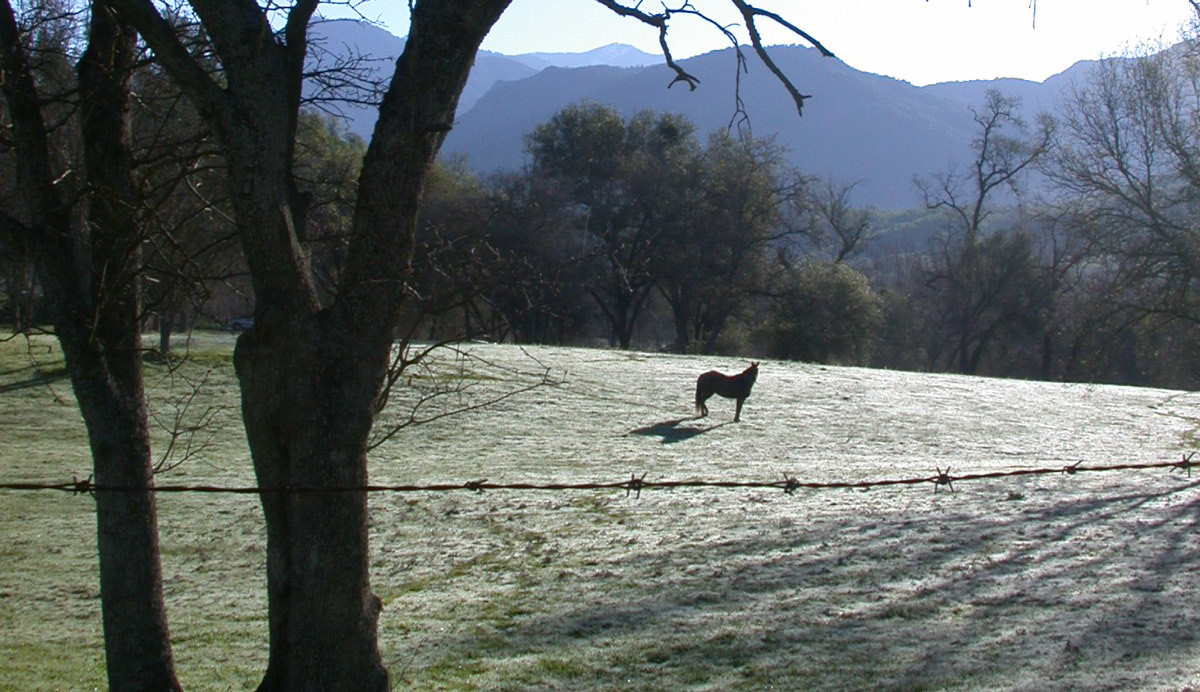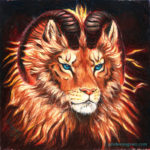
HORSES are of a breed unique to Fantasyland. They are capable of galloping full-tilt all day without rest. Sometimes they do not require food or water. They never cast shoes, go lame, or put their hooves down holes, except when Management deems it necessary, as when the forces of the DARK LORD are only half an hour behind. They never otherwise stumble. Nor do they ever make life difficult for Tourists by biting or kicking their riders or one another. They never resist being mounted or blow out so that their girths slip, or do any of the other things that make horses so chancy in this world. For instance, they never shy and seldom whinny or demand sugar at inopportune moments. But for some reason you cannot hold a conversation while riding them. If you want to say anything to another Tourist (or vice versa), both of you will have to rein to a stop and stand staring out over a VALLEY while you talk. Apart from this inexplicable quirk, Horses can be used just like bicycles, and usually are. Much research into how these exemplary animals come to exist has resulted in the following: no mare ever comes into season on the Tour and no STALLION ever shows an interest in a mare; and few Horses are described as geldings. It therefore seems probable that they breed by pollination. This theory seems to account for everything, since it is clear that the creatures do behave more like vegetables than mammals. It also explains why the ANGL-SAXON COSSACKS and the DESERT NOMADS appear to have a monopoly on horse-breeding. They alone possess the secret of how to pollinate them.
—The Tough Guide to Fantasyland, by Diana Wynne Jones
INTRODUCTION
One of my pet peeves in fiction (mainly fantasy, but this problem does arise in other genres) is the depiction of horses. Not only that horses tend to die faster than any red shirt, or that their owners seem to take the loss with less emotional upheaval than one who has lost their favorite pen, but that in some instances they are written in such a way as to appear so un-horselike that I must assume the writer has not gotten within a mile of an actual horse, and has only done the most rudimentary research—if any has been done at all.
My favorite example of this is in Stardust, a novel written by one Neil Gaiman (who it must be said is quite excellent in many other areas and this does not in any way detract from my high opinion of him). In it there is a unicorn—which is alluded to be a horse-shaped creature of good size—it bears two human-shaped people upon its back at one time—but whose corpse (again with the high mortality rate) is later kicked casually into a trench by a withered old witch.
Now, a healthy person could easily kick the body of a dog, maybe even another human, into a grave, but unless this witch had some unmentioned magical power that gave her kick all the power and force of a backhoe (which is what you need to shift the 1,200 lbs. of weight that is a horse’s corpse), all that should have happened is the witch would have hurt her leg. Or perhaps gone flying backwards at comical speeds.
This is not all. Earlier (when this equine of uncertain mass was still alive), our young hero leaves it in a meadow—presumably covered with grass—while he goes to town. There he buys food for himself, and a “small bale of hay” that he brings back to the unicorn. Which he left in the meadow. Which, unless it was the special kind of meadow that grew pork chops instead of the usual fare (grass and other greenstuff) should have provided the unicorn with sufficient fodder. This is ridiculous enough, but that our hero easily carries a “small bale of hay” was enough to make me put down the book and un-cross my eyes with a pair of pliers.
Hay is essentially dried grass; it is packed into bales on average about five feet long, two feet wide, and maybe one and half feet tall. This author can lift a bale if she has a pair of hay hook or some good gloves, and carry it maybe five feet. Seven, if it’s an emergency. More than that and she needs a wheel barrow or a small tractor. So even a load half this size—I have no idea what a “small bale” is—would be unwieldy at best and finally: a regular horse eats about two flakes of hay (and there are about a dozen flakes in a standard bale) a day. Four, if they are a high-energy thoroughbred or performance horse getting a lot of exercise. Presuming a “small bale” is about six flakes, that is far too much for a single equine in a single feeding. Our hero would have been waiting for a half a day for the unicorn to eat it all, after which it would not have been able to carry him and his heroine anywhere because it would probably have developed a nasty case of laminitis (see Chapter 6: Illness and Injury).
This error is so comical I can only imagine some wires got crossed somewhere and “bale” replaced “flake.” Carrying a small flake of hay back to your unicorn (which you left in a meadow where we must presume it has been doing what any self-respecting equine would do) (eating it) is much more understandable, if still a bit superfluous.
Of course, you can make the excuse that the story was set in a different time and place and these things don’t mean exactly what they mean today… but it is being read today, and this is what people who know horses and know hay will think—they will be like me: utterly bemused and suddenly not inclined to pay much attention to the story because the medium by which it was brought to them (a book) is currently being smacked against their forehead in frustration.
There are many more idiosyncrasies of horseflesh in other books I could mention. The tendency of horses in Jonathan Strange and Mr. Norrell to rear up, fall over, and break their backs. Shadowfax from Lord of the Rings whom I’m convinced was actually a very cleverly disguised car. But if I were to go through all the flubs I’ve caught I’d never get to the point of this article: which is to provide anyone who reads it with the basic knowledge necessary to write horses in such a way that readers like me (who know their stifle from their fetlock, the difference between a running and standing martingale, and what laminitis is) will not break off reading your story to laugh, cry, or slam our faces against the nearest hard, flat surface.
This is not meant as a exhaustive course. I cannot tell you everything. If you really want to write horses well you have to get to know them well, and to do that you are going to have to spend a lot of time working with them (not just watching from a safe distance—don’t let Norman Thelwell fool you). In fact, if you’re writing a book with a lot of horses, I would recommend finding a stable near you and leasing a horse for six months or so. Learn how to feed it, groom it, clean up after it, ride it, and care for it when it inevitably injures itself. You will learn so much, and it will allow you to add little details to your story that, far from causing horse-savvy people such as myself to throw your book across the room, will give us a warm, glowy feeling inside; the feeling that we are in good, knowing hands who have put in the work to really think out the difference between a horse and a bicycle, and to use the knowledge to add depth to their story.
This experience may also make you rethink the wisdom of killing the poor things off when they have reached the end of their usefulness, which we horse-lovers would also appreciate.
However, horses are expensive. They require a lot of time and energy, and not everyone likes being around them. So I will not say you must have hands-on experience and I completely understand not having the resources to do this diligence duly. I’m just saying this way is the best way.
The next best way is to find someone who knows a great deal about horses, and bring your specific questions to them. However, what they tell you will be their own opinions, colored by their own experiences. It is still better to get to know horses for yourself.
But that, like I said, is hard. So I do not expect every writer whose work contains a horse to go out and become a master equestrian as a routine part of their research. But I would like to see horses portrayed more accurately in fiction, and to that end I have compiled this: a guide for writing realistic horses. It is not meant to take the place of hands-on experience, and it is in no way comprehensive. It should, however, point you in the right direction, and give you at least an idea of the kind of creature you are writing about.
Fantasy writers enjoy great liberty when it comes to their worlds: they can always brush things off as “magical” or “alternate”. But horses are a real thing, and if too much is lost or altered they lose their horsiness. They become walking bicycles that breed via pollination, mindless automatons easily acquired and just as easily discarded. And my forehead gets sore from all the books being used to smack it in exasperation.
So, without further preamble, allow me to present:
THE PEDESTRIAN’S GUIDE TO WRITING HORSES
For ease of reading I have broken it down into six chapters, each dealing with different aspects of horses—and one with links to books that got their horses right. I will be posting them over the course of the next week, and as they go live you can reach them by clicking the corresponding link below.
INDEX
~ 1: Terminology ~
~ 2: Physicality ~
~ 3: Personality ~
~ 4: Practicality ~
Goldeen Ogawa has been working with and around horses since she was five years old, has been a horse-owner since 2000, and currently rides every week. If you have any questions about horses not answered here you can email her at goldeenogawa@gmail.com or peck at her on Twitter @GrimbyTweets. There you can also follow her weekly horse pictures under the #TweetsFromHorseback hashtag.






















